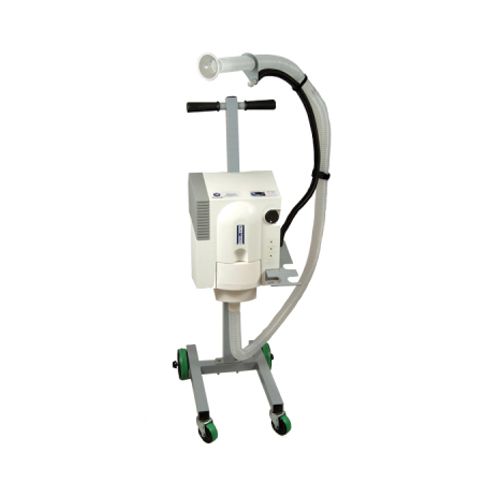Acu-Evac IE-2 Smoke Evacuation System
Acu-Evac IE-2 Smoke Evacuation System
The ACU-Evac smoke evacuation system is ideal for GP practices, outpatient departments and all minor operation theatres. The advanced, patented, high-efficiency filtration system is designed to eliminate surgical smoke plume which may contain hazardous bio-aerosols and live and dead cellular matter (including blood fragments and viruses).
Using a smoke evacuation system will significantly reduce the concentration of surgical smoke in the operating room, posing less risk of contaminated air lingering in the operating room and spreading outside the theatre.
Features:
Very effective solution for evacuation of electrosurgical smoke - removes surgical smoke plume which may contain hazardous bio-aerosols and live and dead cellular matter including blood fragments and viruses.
Eliminates unpleasant odours associated with electrosurgery or cautery.
Acu-Evac filters are designed with charcoal/odour filter and ULPA (Ultra Low Penetration Air) filter technology – rated at 99.99997% efficiency in neutralizing particles between 0.01 and 0.12 μm (micron).
Powerful and portable.
Easily stored.
Designed with space for Hyfrecator* 2000 to be mounted (*hyfrecator not included).
Boom arm allows single operator use, with both hands-free to perform skin surgery.
Contents:
This product is for the Acu-Evac Unit only. To use the unit you must also purchase the required attachments below.
Required Attachments:
MD09675 - Hospital Grade Power Cable - 3 Metres
MD04088 - Acu-Evac - M1 Main Filter
MD07365 - Acu-Evac - Tubing
MD04089 - Acu-Evac - TX Nozzle x 25
Additional Attachments:
To make the Acu-Evac unit fully mobile, the following attachments are recommended:
MD07366 - Acu-Evac - Mobile Stand
MD07364 - Acu-Evac - Boom Arm
MD07367 - Acu-Evac - Footswitch
What is Surgical Smoke Plume?
Surgical smoke plume is a potentially dangerous by-product generated from the use of energy-based devices such as laser and electrosurgical units. These devices cause tissue to vaporise and expel into the air, which is then inhaled by both the patient and clinicians. Approx. 95% of all surgical procedures produce some form of the surgical plume. (Surgical Smoke Plume – Connecting The Dots, 2011).
During electrosurgery, bacteria and viruses, along with a host of chemicals and toxins are released into the air through the smoke plume. This plume contains particles of different natures and varying sizes. The smallest tend to be viruses and travel deepest into the human body.
If a surgical smoke evacuator is not used, these particles are inhaled by anyone nearby and will carry any bacterial and viral pathogens directly into the respiratory system. Toxins known to be in the smoke plume are benzene, carbon monoxide, formaldehyde, hydrogen cyanide, methane, phenol, styrene and toluene.
Human papillomavirus (HPV) has often been linked to the transmission through surgical smoke. Several case studies discuss perioperative professionals working with lasers and electrosurgery devices who have presented with cancerous masses along the airway that are positive for HPV (Surgical Smoke Transmits Infectious Diseases; Here’s How to Stop It, Martha Stratton, 2017).
Who is at Risk?
Both the clinical staff and the patient within the operating room are at risk from the surgical smoke plume. It can however reach far beyond the operating room, putting others at risk as well. Particle concentration in the operating room can rapidly increase within five minutes after the use of electrosurgical devices has begun. Measured 3 meters away from the surgical site, the level of ultrafine particles is between 15% and 30% of the level measured within the breathing area of the surgeon. The high concentration level remains, both during and after the procedure has taken place.
What are the Guidelines?
The Control of Substances Hazardous to Health Regulations (COSHH – 2002) require that exposure to substances hazardous to health, such as surgical smoke plume, are adequately controlled to prevent ill-health.
The HSE (Health and Safety Executive) and NICE (National Institute for Health and Care Excellence) advise that in order to lower the risks caused by surgical smoke plume a smoke evacuation system, such as the Acu-Evac, should be used. The NATN (National Association of Theatre Nurses), state that dedicated smoke evacuators must be used, and the filters checked and changed regularly.
They also suggest high filtration face masks should be worn to minimise the inhalation of carbonaceous particles. There are a huge number of clinical papers to support the value of investing in a smoke evacuation unit, outlining the short term and long-term implications that have been linked directly to smoke plume inhalation. Many of these papers are supported by respected medical associations who highly recommend the use of smoke evacuation systems.
Internal Reference:
MD04087
Lead Time:
1 Working Days
